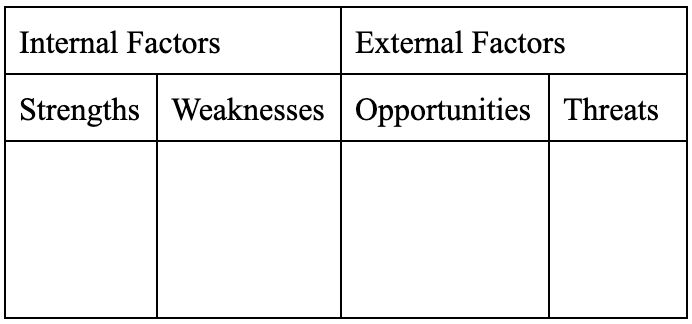As an event planner, you aim to coordinate and host the most successful functions possible. Every event also provides valuable learning opportunities that can help you strengthen your overall organization and improve later events. However, objectively assessing the successes and struggles of your event and company can often take time and effort. An event SWOT analysis is a powerful evaluative method that can provide fast and valuable insight.
SWOT stands for strengths, weaknesses, opportunities, and threats. This framework was first developed in the business world, but many industries and organizations now use it as a strategic planning tool. Learn how a SWOT analysis can help you evaluate and improve your events.
What Is an Event SWOT Analysis?
An event SWOT analysis is a tool that you can use to identify positive aspects of your event that you can build on. It can also detect possible issues you can remedy to help your function succeed.
This productive method can assist you with many steps of the event planning process. For example, you can use a SWOT analysis to:
- Brainstorm new solutions to issues
- Compare your business to competitors
- Discover innovative ways to coordinate your event
- Find new opportunities and areas of potential strength
- Fine-tune your plans for the event
- Identify your organization’s priorities
- Make decisions
- Maximize event potential
- Put your event in context by recognizing relevant economic, market, and social trends
- Respond to possible threats that could derail your event, like a competing function or hazardous weather
- Share your event or organization’s central project goal with employees and sponsors
- Synthesize and assess post-event data, like attendee surveys
The numerous benefits of a SWOT analysis make this framework a valuable addition to any event planner’s toolkit.
How To Perform an Event SWOT Analysis
You don’t need to be a business whiz to perform a SWOT analysis for events. This method is easy and free and requires no specialized knowledge or software.
First, you can create a simple chart to organize your responses to the SWOT analysis. Here’s a basic template:Â

Internal factors refer to your event’s specific advantages and disadvantages and include resources and skills like:Â
- Attendee loyalty
- Brand attributes and reputation
- Budget
- Employee capabilities
- Equipment
- Investors
- Marketing
- Past successes and obstacles
- Profitability
- Sponsors
- Vendors
- Venue
- Volunteers
- Worker productivity
External factors are positive or negative outside forces. You can create strategies to respond to or leverage these factors, but you usually can’t control them. Examples of external considerations include:
- Competitors
- The economy
- Industry trends
- Legislation
- Local demographics
- Natural disasters
- New technologies and tools
- Public transportation
- Supply chain problems
Once you’ve created your SWOT matrix and started brainstorming internal and external factors, you’re ready to identify your event’s strengths, weaknesses, opportunities, and threats. Here are helpful questions that can help you complete each step of the evaluation.
Strengths
A strength includes any internal factor that functions effectively and is a key determinant in your event’s overall success. To identify your strengths, consider these questions:
- Do you have a broad and enthusiastic social media following?
- Do your workers and volunteers have specialized knowledge or valuable skills?
- Have you developed a unique brand?
- How have you taken advantage of your venue’s unique affordances, like access to public transportation, the layout, or on-site staff?
- What connections have you made with current or potential sponsors and stakeholders?
- What makes your event stand out from competitor functions?
- What valuable insights have you gained from past events that you can apply to future functions?
- Which aspects of your event do your attendees enjoy the most?
Highlighting your event’s strengths can help you expand and maintain the best features.
Weaknesses
A weakness is any internal characteristic or process that could limit your event’s success. It can often be difficult to pinpoint specific flaws — especially if you haven’t organized a similar event before — but here are a few areas to consider:
- Do you lack sufficient financial resources to achieve your goals?
- Does your event have little or no social media presence?
- Does your team lack adequate skills and training to run your event?
- Has your brand received little recognition?
- Have you ineffectively marketed your event to your target demographic?
- Have you not created a backup plan to handle unforeseen challenges?
- Is your event management system ineffective?
- Is your team unenthusiastic and unmotivated to improve?
- What aspects of past events have left attendees dissatisfied?
- What obstacles have you encountered during past events?
Identifying your event’s weaknesses can sometimes be painful, but this exercise can help you develop a strategy to tackle each issue.
Opportunities
Many external factors could boost your event’s success and help you accomplish your goals in innovative new ways. Your team can brainstorm about these potential opportunities:
- Are you in a niche market?
- Can you conduct audience satisfaction analyses at the event to gather knowledge for future functions?
- Can you engage with new audiences to widen your event’s reach?
- Can you provide additional training to help your staff refine their skills?
- Can you reconnect with past attendees to increase excitement about your event and build loyalty?
- Do you have creative staff who can develop new branding ideas or design new merchandise?
- Do you have room in your budget to expand your event marketing plan?
- Have recent events or industry trends improved the market situation in your area?
- Have you identified potential new sponsors?
- Would new technologies — such as revolutionary event management software or an easy parking mobile application — improve your event?
Finding new possibilities can help you reimagine your event and develop stronger relationships with attendees, sponsors, and staff.
Threats
Finally, it’s essential to recognize potential threats that could complicate the event planning process or prevent you from meeting your goals. These questions can help you detect external obstacles:
- Are you hosting an outdoor event that could be cancelled due to bad weather?
- Could new legislation, like laws about noise or parking, restrict your event?
- Do people view your organization negatively?
- Has your target audience shrunk?
- Have costs for supplies or venues risen?
- Have changing cultural or political trends made your event less relevant or popular?
- Is a competitor planning a similar event?
- Is the local or national economy suffering a downturn that could reduce your attendance?
You may not be able to avoid all possible threats, but you can regain control by developing a plan to cope with any developing challenges.
Why You Should Execute a SWOT Analysis While Planning Your Event
A SWOT analysis of event management is a simple process that can provide several significant benefits.
Set More Realistic Event Goals and Achieve Them
Identifying potential weaknesses and threats can help you develop more realistic event goals. For example, the SWOT analysis may reveal that you don’t have a sufficient budget to hire a highly desirable performer for your entertainment event. Based on this finding, you could hire several lesser-known performers and adjust your attendance goal.
Optimize Your Event Marketing Campaign
An event SWOT analysis can enable you to recognize marketing successes and expand these techniques to attract new demographics. One of your strengths may be a memorable social media campaign, like a series of short videos that advertise your brand to parents. You could adapt this technique to a new social media platform to reach younger audiences or create similar videos addressed to a different potential audience, like grandparents.
Similarly, identifying weaknesses can help you cross ineffective advertising techniques off your event marketing checklist.
Forecast Event Performance
The SWOT matrix can help you predict your event’s performance and adjust your plans accordingly. While completing the threats or weaknesses boxes, you may realize that a new competitor will likely reduce your event’s attendance. Based on this realization, you could choose a smaller venue and scale back staff, conserving your budget for other areas.
Identify and Predict Potential Setbacks Ahead of Event
A SWOT analysis lets you detect and prevent possible challenges before your event begins. For example, you may realize that you have an inexperienced event team with insufficient customer skills or that a thunderstorm could wreak havoc on your outdoor festival. Based on this knowledge, you can develop tactics to avoid these setbacks, like providing a staff training seminar or renting tents.
Helps With Solving Event Challenges in Real Time
Even the best event planning can’t stop all setbacks. During your event, you can use the SWOT analysis to respond to obstacles in real time by drawing on your strengths, like an employee with relevant skills or extra room in the budget for emergency supplies.
Manage Your Events Strategically and Successfully With Events.com
Conducting a SWOT analysis is a great way to develop your existing strengths, shore up your weaknesses, seek new opportunities, and respond to potential threats. This method can help you view your event from a more objective standpoint. You can even fill out your SWOT analysis with your event team, allowing you to gather feedback and ideas from staff.
Once you’ve identified areas of improvement and new opportunities, it’s time to create an event strategy to take your function to the next level. Events.com’s affordable and easy-to-use Event Management Software can help you with every step of the event planning process, from attendee registration to merchandise sales. Get in touch today to learn more about how we can take the stress out of event planning and help you achieve your event planning goals.







